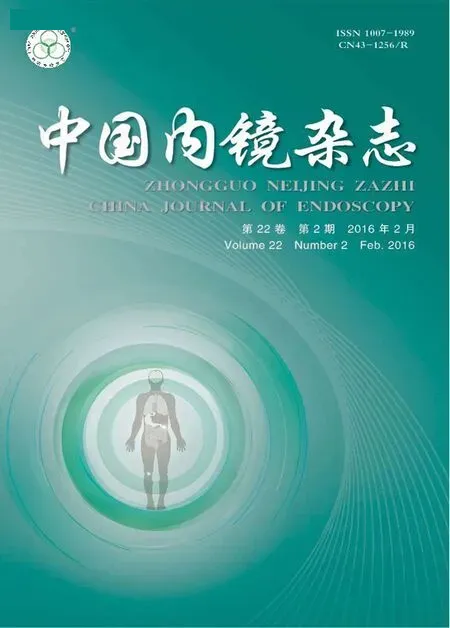胰腺癌同步放化疗后放射性胃、十二指肠溃疡发生的临床研究
郭小陪,魏华琳,陈晓,张夏璐,刘建辉,周平
(中国人民解放军空军总医院肿瘤放疗科,北京100142)
论著
胰腺癌同步放化疗后放射性胃、十二指肠溃疡发生的临床研究
郭小陪,魏华琳,陈晓,张夏璐,刘建辉,周平
(中国人民解放军空军总医院肿瘤放疗科,北京100142)
目的描述胰腺癌放疗致放射性胃、十二指肠损伤的内镜下表现,研究放疗同步S-1(替吉奥胶囊)、吉西他滨化疗对放射性溃疡发生的影响。方法对空军总医院2010年2月-2015年5月胰腺癌单纯放疗及放疗同步替吉奥、吉西他滨化疗患者的放疗前、后上消化道内镜下表现进行自身对比研究。以Pearsonχ2检验分析单纯放疗组与放化同步组的放射性溃疡发生率差异有无统计学意义。结果单纯放疗组、放疗同步替吉奥化疗组、放疗同步吉西他滨化疗组放射性溃疡发生率分别为44.1%(26/59)、50.0%(10/20)和46.7%(7/15);3组间放射性溃疡发生率差异无统计学意义(P=0.897)。结论从胰腺癌放化同步对胃、十二指肠安全的角度考虑,患者可根据自身情况同步应用替吉奥、吉西他滨化疗,同步化疗与否对放射性溃疡的发生影响差异无统计学意义。
胰腺癌;放化疗;胃十二指肠;溃疡
随着伽马刀、螺旋断层调强放射治疗等先进技术的发展,目前放疗已广泛应用于不可切除的局部晚期胰腺癌治疗、可切除胰腺癌的术后辅助治疗,以及局部可切除但拒绝手术的选择性根治。同时,放化同步在胰腺癌的治疗地位中与日俱增,尤其是对局部进展期胰腺癌。部分研究[1-3]证实了放化同步可增加患者的生存期,所以,放化同步治疗经常取代单纯放疗。当前胰腺癌放疗的常规处方剂量在60~70Gy[4],胃、十二指肠毗邻胰腺,在大于40Gy的照射剂量后便会呈现出具有一定特征的损伤—放射性黏膜炎及放射性溃疡。现有临床实验证实了吉西他滨、替吉奥均有一定的胃肠毒性,吉西他滨较氟尿嘧啶类对胃肠道毒性更强[5-6]。本研究通过比较单纯放疗与放化同步对溃疡发生的影响,对此医源性疾病的认识进一步提升。
1 资料与方法
1.1一般资料
收集本院2010年2月-2015年5月胰腺癌行放疗的病例。入选标准:①年龄≤80岁,功能状态评分(karnofsky performance status,KPS)≥70分;②患者行单纯放疗,或者规律同步替吉奥、吉西他滨化疗。排除标准:①无放疗前内镜检查做对比;②因失访、拒绝等原因未行放疗后内镜检查。
对比研究共入组94例患者。其中,男55例,女39例,单纯放疗患者59例,20例患者放疗同步口服替吉奥胶囊化疗,15例患者放疗同步吉西他滨化疗。患者平均年龄为58.6岁(33~76岁),平均KPS评分为82.6分(70~95分)。多数患者采用伽马刀、螺旋断层调强放射治疗(tomotherapy system,TOMO)放疗技术,分别为28例(29.8%)、63例(67.0%)。行内镜检查的中位时间为放疗后1个月。
所有入组病例均有放疗前、开始后内镜检查结果,放疗过程中及放疗后内镜检查时间结合患者上消化道毒副反应进行,内镜观察至十二指肠水平段。
1.2研究方法
1.2.1放疗技术采用伽马刀、三维适形放疗(three-dimensional conformal radiotherapy,3-D)、直线加速器调强放疗(intensity modulated radiation therapy,IMRT)和TOMO等放疗技术。伽马刀处方剂量:周边50.0%等剂量线,肿瘤靶区(gross tumor volume,GTV):45.0~51.0Gy/15~17 f,单次剂量GTV:3 Gy/f;3-D放疗处方剂量:周边90.0%等剂量线,GTV/临床靶区(clinicaltarget volume,CTV):60.0Gy/ 50.0 Gy/25 f,单次剂量GTV/CTV:2.4 Gy/2 Gy/f;IMRT及TOMO放疗处方剂量:周边95.0%等剂量线,GTV/CTV:60.0~70.0Gy/50.0~66.0Gy/15~25 f。采用常规分割,1 f/1 d,5 f/1WK。
1.2.2同步化疗方法同步替吉奥化疗方法:50mg 2次/d,D1~14,周期21 d;同步吉西他滨化疗方法:1 g/m21次/周,周期21 d。
1.2.3放射性胃、十二指肠损伤相关定义①放射性胃、十二指肠炎:在受照区域新发的,或在原有病变之上恶化的弥漫性红斑、渗出、水肿和充血等黏膜改变;②放射性胃、十二指肠溃疡:在放射性胃、十二指肠炎基础上发生的放射性溃疡,在原有溃疡基础上加重的或出现新发的放射性溃疡[5-7]。
1.3统计学方法
数据采用SPSS 22.0统计软件进行分析,以Pearsonχ2检验分析单纯放疗组、放疗同步替吉奥化疗组和放疗同步吉西他滨化疗组3组间溃疡发生率有无差异。以P<0.05为差异具有统计学意义。
2 结果
单纯放疗组、放疗同步替吉奥化疗组和放疗同步吉西他滨化疗组放射性溃疡发生率分别为44.1%(26/59)、50.0%(10/20)和46.7%(7/15)。放射性炎症内镜观察为胃、十二指肠的黏膜弥漫性充血、水肿、糜烂,黏膜红白相间,散在红斑,偶呈花斑样改变,脆性增加,触之易出血,见附图A和B。附图C和D显示,放射性溃疡内镜下观察为单发或多发的胃、十二指肠壁溃疡,表面覆白苔,周围黏膜肿胀充血明显,病理多提示黏膜慢性活动性炎伴大片炎性渗出及坏死组织。经Pearsonχ2检验,单纯放疗组、放疗同步替吉奥化疗组和放疗同步吉西他滨化疗组3组间溃疡发生率差异无统计学意义(P=0.897)。见附表。

附图放射性胃十二指肠炎症、溃疡内镜下表现

附表单纯放疗与同步替吉奥、同步吉西他滨化疗对溃疡发生的影响例
3 讨论
射线对黏膜细胞、血管上皮细胞的损伤机制考虑辐射致DNA损伤、DNA链断裂、细胞膜破坏,使细胞增殖、分化受影响,导致细胞裂解、死亡[7-9]。有关研究证实,上消化道黏膜对射线极度敏感,射线可损伤胃黏膜表面的黏液层和柱状上皮细胞,导致分泌胃液的功能改变[10],低剂量照射可导致胃酸的分泌减少50.0%,并且持续时间大于1年[11]。射线可从胃肠黏膜的机械屏障、免疫屏障、化学屏障及生物屏障等多个方面击破消化道的防御功能[12-15]。在显微镜下,放射性胃炎的黏膜可出现充血和水肿改变,黏膜下血管出现渗出、出血的改变,同时伴有壁细胞、主细胞的胞质及分泌颗粒的减少[16]。胃、十二指肠放射性损伤急性期(3个月内)多表现为黏膜的急性渗出性炎症,或形成动脉内膜炎,使血管闭塞,导致黏膜缺血、溃疡形成,晚期则多表现为黏膜僵硬、纤维化和瘢痕形成。
替吉奥作为一种氟尿嘧啶衍生物口服抗癌制剂与吉西他滨多同步用于胰腺癌的放疗,以作用于肿瘤细胞的不同增殖周期,增加放疗的敏感性[17]。两者作为抗代谢类药物,均有一定的胃肠道毒性,在抑制肿瘤细胞生长的同时,使胃肠道黏膜的损伤修复能力减弱,增加了放射性黏膜损伤发生的风险。放射性溃疡可致瘢痕形成,甚至使局部狭窄、梗阻,严重影响了患者的生活质量,放疗过程中发生的溃疡因继续放疗可增加穿孔、出血的风险,往往使治疗中断。因此,胰腺癌同步放化疗对胃、十二指肠放射性溃疡发生的评估对临床医生甚为重要。
Takatori等[18]在化疗联合质子放疗治疗胰腺癌的研究中证实,放疗前是否行化疗(吉西他滨或替吉奥)与发生放射相关性溃疡差异无统计学意义(P= 0.174)。在一项放疗联合吉西他滨、5-Fu、吉西他滨和5-Fu治疗胰腺癌的研究中[19],3组放射性溃疡发病率差异无统计学意义。有关研究报道[20],放疗后产生的溃疡发生的峰值时间为放疗后1~2个月,本研究行内镜检查的中位时间为1个月,较符合损伤观察的时机。在本研究中,规律同步替吉奥、吉西他滨化疗例数分别为20和15例,尚未得出放疗同步替吉奥、吉西他滨的溃疡发生率与单纯放疗组有差异,与Didolkar等[21]的报道相似,放疗对局部进展期胰腺癌的胃肠道黏膜损伤(III级或IV级)与化疗无关。现有关放射性胃、十二指肠损伤的严重程度与化疗药物的种类及化疗药物的使用方式、剂量的相关性不甚清楚,并缺乏将不同的化疗药物进行对比的研究,当前尚无大样本研究证实化疗与胃、十二指肠放射性溃疡有关联。因此,从胰腺癌同步放化疗对胃、十二指肠的安全角度考虑,可根据患者病情需要及耐受情况,放疗时可同步应用合适的化疗方案来取得更好的疗效,延长生存期。
[1]Shinchi H,Takao S,Noma H,et al.Length and quality of survival after external-beam radiotherapy with concurrent continuous 5-fluorouracil infusion for locally unresectable pancreatic cancer[J].Int J Radiat Oncol Biol Phys,2002,53(1):146-150.
[2]Huguet F,AndréT,Hammel P,et al.Impact of chemoradiother apy after disease control with chemotherapy in locally advanced pancreatic adenocarcinoma in GERCOR phase II and III studies[J].J Clin Oncol,2007,25(3):326-331.
[3]Nakachi K,Furuse J,Kinoshita T,et al.A phase II study of induction chemotherapy with gemcitabine plus S-1 followed by chemoradiotherapy for locally advanced pancreatic cancer[J].Cancer Chemother Pharmacol,2010,66(3):527-534.
[4]任刚,王竞,夏廷毅.胰腺癌综合诊治中国专家共识(2014年版)放射治疗部分的解读[J].临床肝胆病杂志,2014,30(12):1249-1252.
[5]Crane CH,Abbruzzese JL,Evans DB,et al.Is the therapeutic index better with gemcitabine-based chemoradiation than with 5-fluorouracil-based chemoradiation in locally advanced pancreatic cancer[J].Int J Radiat Oncol Biol Phys,2002,52(5): 1293-1302.
[6]Huguet F,Girard N,Guerche CS,et al.Chemoradiotherapy in the management of locally advanced pancreatic carcinoma:a qualitative systematic review[J].J Clin Oncol,2010,27(13): 2269-2277.
[7]Hall EJ.Radiobiology for the radiologist[M].Philadelphia:Lippin-cott Williams&Wilkins,2000:165-167.
[8]Bismar MM,Sinicrope FA.Radiation enteritis[J].Curr Gastroenterol Rep,2002,4(5):361-365.
[9]Nguyen NP,Antoine JE,Dutta S,et al.Current concepts in radiation enteritis and implications for future clinical trials[J].Cancer 2002,95(5):1151-1163.
[10]Feldman M,Scharschmidt BF,Sleisenger MH,et al.Sleisenger &Fordtran’s gastrointestinal and liver disease:Pathophysiology,diagnosis,management.Ch:38 Radiation injury to the gastrointestinal tract[M].8th edition.WB Saunders,2006:815-816.
[11]Palmer W.Gastric irradiation in peptic ulcer[M].Chicago:University of Chicago Press,1974,230(9):1329.
[12]李荣富,李欣,吴姗珊.伽马刀放疗腹膜后淋巴结转移癌对肠道菌群的影响[J].东南大学学报:医学版,2012,31(1):72-78.
[13]Wang H,Zhang W,Zuo L,et al.Intestinal dysbacteriosis contributes to decreased intestinal mucosal barrier function and increased bacterial translocation[J].Lett Appl Microbiol,2014,58(4):384-392.
[14]Geuking MB,McCoy KD,Macpherson AJ.The function of secretory IgA in the context of the intestinal continuum of adaptive immune responses in host-microbial mutualism[J].Semin Immunol,2012,24(1):36-42.
[15]Mantis NJ,Rol N,Corthésy B.Secretory IgA's complex roles in immunity and mucosal homeostasis in the gut[J].Mucosal Immunol,2011,4(6):603-611.
[16]Coia LR,Myerson RJ,Tepper JE.Late effects of radiation therapy on the gastrointestinal tract[J].Int J Radiat Oncol Biol Phys,1995,31(5):1213-1236.
[17]Kim HM,Bang S,Park JY,et al.Phase II trial of S-1 and concurrent radiotherapy in patients with locally advanced pancreatic cancer[J].Cancer Chemotherapy and Pharmacology,2009,63(3):535-541.
[18]Takatori K,Terashima K,Yoshida R,et al.Upper gastrointestinal complications associated with gemcitabine concurrent proton radiotherapy for inoperable pancreatic cancer[J].Gastroenterol,2014,49(6):1074-1080.
[19]Lee KJ,Kim HM,Jung JW et al.Gastrointestinal hemorrhage after concurrent chemoradiotherapy in locally advanced pancreatic cancer[J].Gut and Liver,2013,7(1):106-111.
[20]Coia LR,Myerson RJ,Tepper JE.Late effects of radiation therapy on the gastrointestinal tract[J].Int J Radiat Oncol Biol Phys. 1995,31(5):1213-1236.
[21]Didolkar MS,Coleman CW,Brenner MJ,et al.Image-guided stereotactic radiosurgery for locally advanced pancreatic adenocarcinoma results of first 85 patients[J].J Gastrointest Surg,2010,14(10):1547-1559.
(曾文军编辑)
Radiotherapy induced gastroduodenal ulcer after concurrent chemoradiotherapy in pancreatic cancer
Xiao-pei Guo,Hua-lin Wei,Xiao Chen,Xia-lu Zhang,Jian-hui Liu,Ping Zhou
(Departmentof Radiotherapy,General Hospital of PLA Air Force,Beijing 100142,China)
Objective To describe the endoscopic observation of pancreatic cancer radiotherapy induced gastroduodenal radioactive injury,and investigate the influence of radiation-induced ulceration by concurrent chemoradiotherapy with S-1(Tegafur Gimeracil Oteracil Potassium Capsule)and gemcitabine.Methods Self-comparative study of endoscopic performance were performed on patients
endoscopy before and after pancreatic cancer Chemoradiotherapy with S-1 or gemcitabine or radiotherapy only,from February 2010 to May 2015.Pearson chisquare test was used to analyze whether Concurrent Chemoradiotherapy groups and radiotherapy group are different in radiation-induced ulceration occurrence rate.Results The incidence of radiation-induced ulceration of radiotherapy group,S-1 group and gemcitabine group are 44.1%(26/59),50.0%(10/20)and 46.7%(7/15),respectively. Radiation-induced ulceration incidence was no statistical difference among the three groups.Conclusion From the angle of safety,patients can according to their self-condition for choosing S-1 or gemcitabine chemotherapy.Wether the concurrent chemoradiotherapy treatment was adopted or not,the occurrence rate of radiation-induced ulceration has no significant difference.
pancreatic cancer;chemoradiotherapy;gastroduodenal;ulcer
R 735.9;R 573.1
A
10.3969/j.issn.1007-1989.2016.02.011
1007-1989(2016)02-0046-04
2015-11-18
周平,E-mail:zhouping4946@163.com

